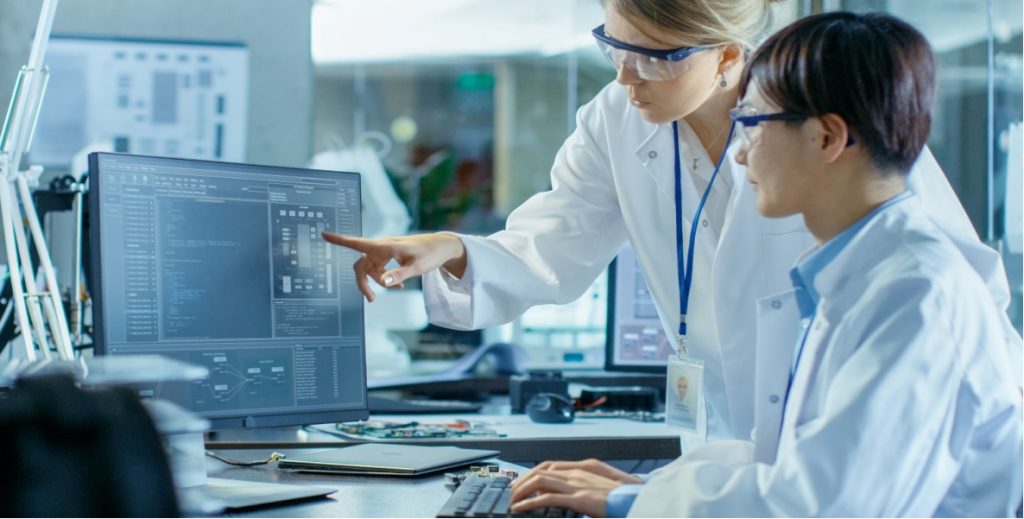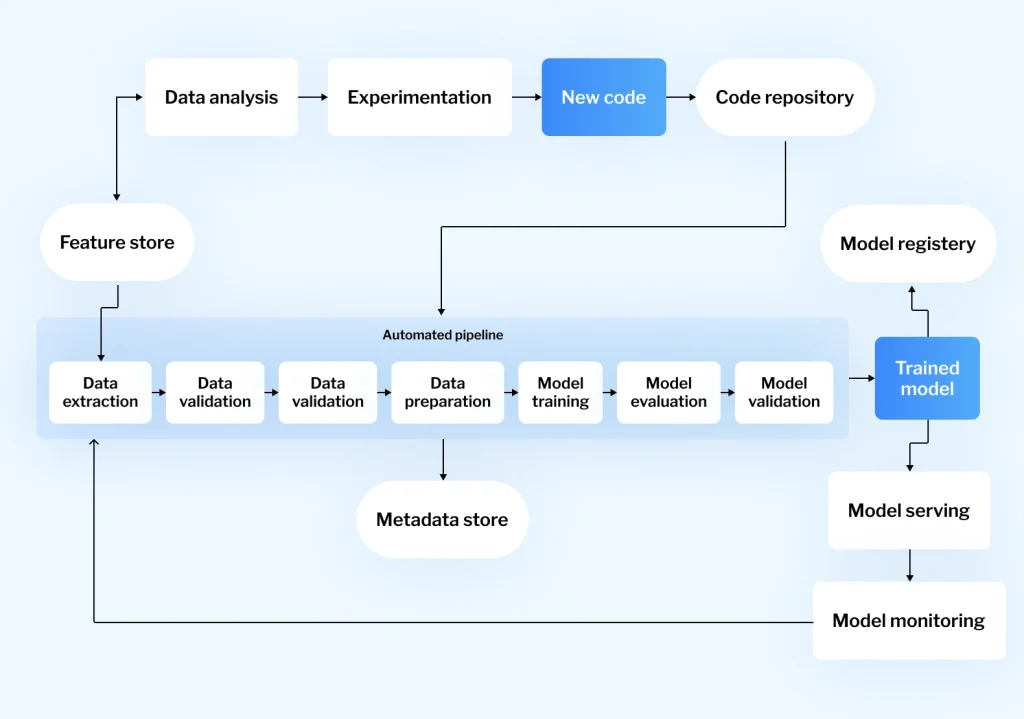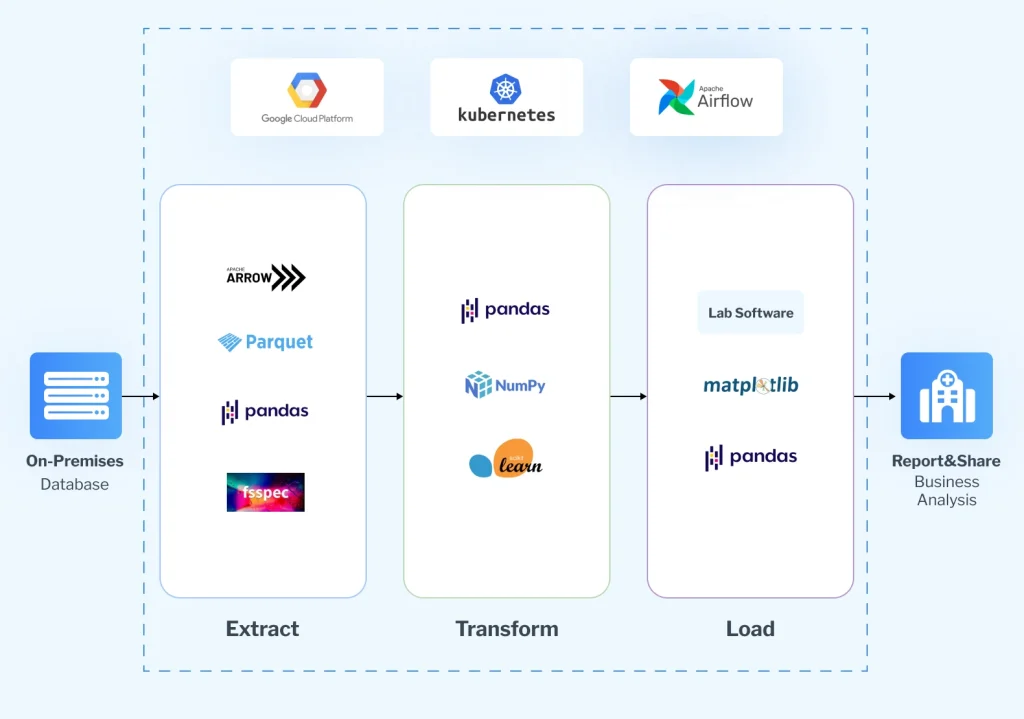We use cookies to ensure we give you the best experience on our website. By clicking Agree you accept our Privacy and Cookies Policy.
How to build laboratory diagnostics software from scratch: our experience

 17 minutes read
17 minutes read
Content
The software development process for healthcare laboratory applications is a complex and challenging undertaking. In addition to the technical challenges of developing software that is accurate, reliable, and compliant with regulatory requirements, there are also business considerations such as managing customer expectations, ensuring timely delivery of features, and maintaining a high level of quality.
In this article, we will explore common stages of laboratory software development. We will also provide tips on overcoming challenges by selecting the right tools and partners for your project.
What is the difference between LIS and laboratory diagnostics software?
Laboratory Information System (LIS) or Laboratory Information Management System (LIMS) are primarily used to manage patient data, test results, and other lab-related information. It often includes ordering tests, tracking specimen status, generating reports, sending results to physicians, etc. Many LIS systems also offer some degree of billing support.
Laboratory Diagnostics Software is designed specifically for clinical diagnostics and biomedical research. It typically provides more detailed tools and functionality than a LIS system, including instrument interfacing capabilities, advanced result analysis options, quality control functions, etc. In some cases, it may also include basic ordering and report generation features similar to those found in LIS software.
Understanding laboratory data management ecosystems: LIMS, LIS, SDMS, and ELN
While often used interchangeably, various systems contribute to a robust laboratory data management infrastructure. Understanding their distinctions is crucial for tailoring an effective software solution.
- Laboratory Information Management System (LIMS): A comprehensive system designed to manage and track samples, experiments, results, and workflows across the entire laboratory process. LIMS systems are essential for labs with high sample volumes, complex workflows, and stringent regulatory requirements, offering capabilities such as sample lifecycle management, instrument integration, and robust reporting.
- Laboratory Information System (LIS): Primarily focused on clinical diagnostics, an LIS manages patient-centric data, test orders, results reporting, and often interfaces directly with hospital information systems (HIS). Its core function is to streamline patient sample processing and ensure accurate and timely diagnostic results for healthcare providers.
- Scientific Data Management System (SDMS): Specializes in capturing, storing, and managing large volumes of unstructured data generated by laboratory instruments. SDMS ensures data integrity, facilitates data archiving, and provides tools for searching and retrieving raw data, often complementing LIMS by managing data that doesn’t fit into structured LIMS fields.
- Electronic Lab Notebook (ELN): A digital replacement for traditional paper lab notebooks, ELNs are used by scientists to document experiments, procedures, observations, and results. They enhance data organization, collaboration, and searchability, providing a rich record of research activities and intellectual property.
What issues does laboratory software solve?
Accurate and timely patient results are essential for quality healthcare. They are also necessary for billing and reimbursement purposes. Therefore, it’s hard to overestimate the value of laboratory diagnostics software, as it helps laboratories and healthcare facilities improve the accuracy of clinical decisions.
Laboratory software helps healthcare companies automate business processes, as it covers a broad range of functions necessary for running a successful lab. These include workflows, data management, and compliance. It typically contains modules for order entry, result reporting, specimen tracking, analysis, and troubleshooting.
A well-designed system tracks specimen types from collection through testing and result reporting. Documenting each step of the process can quickly identify and correct errors, improving overall efficiency in the laboratory workflow. In addition, precision diagnostics systems integrate with other applications to provide valuable insights into laboratory performance by tracking key data points such as turnaround times and error rates.
Features to include in your laboratory software
- Sample preparation guidance automates many tedious and time-consuming steps involved in preparing samples for analysis.
- Integration with laboratory instruments and hardware enables seamless data exchange and connectivity of various devices across the lab.
- Analyzing and interpreting test results powered by self-learning algorithms eliminates human-prone errors and streamlines issue resolution.
- Compatibility with LIMS or LIS system helps to avoid duplicate data entry and improves in-team and cross-team collaboration.
- Ease of use involves building a simple but sophisticated user interface that optimizes complex workflows within the lab and enhances the overall user experience.
- Built-in troubleshooting allows users to identify and fix problems with their tests quickly.
- Compliance with FDA, HIPAA, and ETL infrastructure for effective and secure healthcare data storing and processing.
Tailoring software to specific laboratory needs
The optimal laboratory diagnostics software is not a one-size-fits-all solution; it must align with the specific operational context and data demands of each lab. Different laboratory environments, from clinical diagnostics to advanced research and development, have unique requirements that dictate software functionality.
- Clinical and Diagnostic Laboratories: These labs prioritize efficient patient sample throughput, regulatory compliance (e.g., HIPAA, FDA), seamless integration with electronic health records (EHRs), and precise result reporting to healthcare providers. Software solutions must support rapid turnaround times, robust quality control, and secure data exchange.
- Research and Development (R&D) Labs: Focus on managing complex experimental data, integrating with a diverse array of instruments, and supporting collaborative research efforts. Key features include flexible data modeling, advanced analytics, data visualization tools, and compatibility with various assay types to accelerate scientific discovery.
- Manufacturing and Quality Control (QC) Labs: Emphasize process control, adherence to Good Manufacturing Practices (GMP), batch management, and comprehensive audit trails. Software for these labs must ensure product quality, support regulatory submissions, and provide traceability throughout the production lifecycle.
- Environmental and Public Health Labs: Require robust sample tracking, adherence to environmental regulations, and capabilities for monitoring and reporting on public health metrics. Data integrity and the ability to handle diverse sample types (water, air, soil) are paramount.

Laboratory software development do’s and don’ts: glance at the technical side
One thing is crystal clear: the right combination of programming languages, tools, and frameworks can make or break your future project. Your choice of technologies determines whether your product will be scalable and competitive after the launch, so choose wisely!
Below, we will share what we learned from building laboratory diagnostics software during our collaboration with a US-based health tech startup.
Choose the right programming language
.NET services is a powerful tool for laboratory software development that offers many benefits over other platforms. One key advantage is .NET’s ability to interoperate with existing code and platforms, allowing laboratories to leverage their existing investments.
What’s more, .NET provides comprehensive support for developing highly secure applications – an important consideration in the sensitive world of medical data. Another significant benefit is that .NET can be used to create web-based and desktop applications, giving laboratories great flexibility in deploying their solutions.
We chose .NET as the core programming language for our laboratory diagnostics software project. Why? First of all, it works exceptionally well when combined with React JS and other development platforms used by our client. Second, it gives us the freedom to implement complex functionality while keeping the backend elegant and simple.
Craft a user-friendly interface
Here are 5 tips on how to build a user-friendly interface for laboratory diagnostics software:
- Make it intuitive. The layout of your software should be easy to understand and use. All features and functions should be clearly labelled and easy to find.
- Use templates. Many laboratory tests follow similar protocols, so using templates can help simplify the process for users. Include fields for common data points that need to be collected for each type of test, as well as for instructions on how to perform the test.
- Allow customization. Lab technicians should be able to tailor the software to their needs by creating custom views or reports based on their preferences. This will help them work more efficiently by only accessing the information they need when they need it.
- Include built-in HELP. A user-friendly interface should include help documentation or tutorials to assist users in using your lab software. This way, they can get the most out of your platform.
- Enable real-time data entry. Data entry should be streamlined and easy, allowing users to input information quickly and without errors. Real-time data entry will enable clinicians to see results while entering and confirm their accuracy.
From our experience, creating an efficient user interface involves a deep understanding of your users’ needs and project goals. It is rarely possible for healthcare startups, as the nature of startups implies frequent changes. Once you settle business considerations, you can always revamp your app’s interface with the help of experts in UX/UI design.
Enhance your lab software with ML algorithms
Anyone who works in the lab uses some laboratory software to manage their work. But what if that software could get smarter over time, learning from the data and improving its own performance?
That’s the idea behind building laboratory diagnostics software with machine learning algorithms. By incorporating these algorithms into your software, you can create a system that gets better at completing tasks as it gains more experience.
There are two common ways to implement machine learning in laboratory software:
- Supervised learning algorithms to automatically recognize patterns in new data based on existing samples of datasets. This can optimize procedures for speed or accuracy or expand the range of tests conducted.
- Predictive modeling is used to identify trends in data sets and make predictions about future behavior – for example, estimating how likely a microbiology sample will respond positively to a particular treatment.
In general, nearly any task requiring human intervention could be automated with artificial intelligence or machine learning. The key is building up datasets to train these models – typically, this requires working with real-world data rather than simulated environments. However, it’s not as easy as it sounds. Ideation, design, accumulation, and maintenance of data for datasets is a time-consuming and effortful process.
Developers often face the challenge of creating custom datasets to meet the product’s unique needs. That’s why hiring dedicated developers with solid machine learning background is critical for your healthcare app success. Once you have training data, developing and testing ML models is an iterative process involving multiple rounds of tweaking and refinement until an acceptable level of accuracy is achieved.

Laboratory software automated ML pipeline
Our task was to build a web-based laboratory diagnostics system that delivers fast and accurate AST results. To make it happen, we needed not just machine learning algorithms, but a complete data-driven framework. Here’s how we did it.
We relied on powerful Python-based solutions, namely Scikit-learn – an open-source library for predictive data analysis, which brings together the most effective machine learning models. Combined with Numpy, Scipy, and Pandas for reliable healthcare data processing and storing, this library helped us develop ML algorithms that analyze antibiotic dilutions and determine the ones that respond best to patients’ plasma, providing insights into the most effective treatment.
Since ML model training is a complex and computation-heavy process, the training modules were designed to be parallelized and used effectively in conjunction with cloud infrastructure. Our cloud developers implemented the ETL pipeline by using Google Cloud Platform with Docker, Kubernetes, and Apache Airflow for effective ML training and computation. On top of that, we implemented a serialization mechanism that ensures our models are properly loaded and maintained across different environments.

Laboratory software automated ETL toolset
Create a comprehensive testing plan
The planning stage should include everything from high-level design concepts down to minute details like how individual modules will interact. By taking care of as many potential issues as possible upfront, you can avoid costly delays or rework further down the line.
Once you have your blueprint in place, it’s time to start building out the actual laboratory diagnostics software. As each new component is added, take some time to test it thoroughly before moving on — if something doesn’t work correctly now, the chances are good that it never will. In addition to unit testing individual pieces of code, perform regular system-wide tests to catch any errors that might only become apparent when everything is put together.
Our experience shows that software testing is crucial for laboratory software development. We put a lot of effort into ensuring everything from the initial data input to getting, analyzing, storing, and exporting results works without a hitch. Integration testing is another key step in this process; not only does this help uncover potential bugs, but it also gives insights into performance bottlenecks that could affect the user experience negatively.
Last but not least – User Acceptance Testing (UAT) – allows stakeholders and other interested parties to yield their verdict on whether the end product meets their needs. If it doesn‘t have buy-in at this stage, then going live with your software will likely be fruitless.
Build an MVP
Creating a Minimum Viable Product (MVP) allows you to validate your assumptions about the product and its market, gather customer feedback, and iterate on the design before investing too much time or money in the final product.
When it comes to developing laboratory software, there are several critical steps for building an MVP:
- Consider what features are vital for the software to be functional, aka your core features. For example, if you’re creating a new type of microscope that can take pictures at different depths, one of your core features might be the ability to focus at different depths. Other essential factors could include compatibility with other lab equipment and ease of use.
- Start thinking about how to simplify your core features even further so they can be quickly implemented and tested with users. This means removing some non-essential functionality or making certain trade-offs in performance or quality to get the MVP out as soon as possible.
Again, the goal is not to create a perfect product – instead, it’s to create something that provides value to users and helps you learn more about their needs to continue improving upon it over time.
Ensuring data integrity and security in laboratory software
In the realm of laboratory diagnostics, the integrity and security of data are non-negotiable. Beyond merely adhering to regulatory mandates, robust data security frameworks build trust and ensure the reliability of diagnostic outcomes.
- Comprehensive Compliance: While HIPAA is critical for protected health information (PHI), consider other relevant compliance standards depending on the lab’s operational scope. These may include GxP (Good Practice guidelines such as GLP, GCP, GMP), CLIA, ISO 17025, and GDPR (for European contexts). Articulating adherence to these diverse standards demonstrates a holistic approach to regulatory compliance.
- Advanced Security Protocols: Implement multi-layered security measures, including end-to-end encryption for data in transit and at rest, stringent access controls (role-based access, multi-factor authentication), and regular security audits. Data segregation and anonymization techniques are also vital, particularly in research environments dealing with sensitive patient information.
- Data Integrity and Audit Trails: Design the software to maintain an unalterable audit trail of all data entries, modifications, and access events. This ensures traceability and accountability, crucial for troubleshooting, regulatory inspections, and maintaining data veracity. Version control for documents and protocols further safeguards data integrity.
- Disaster Recovery and Business Continuity: Plan for unforeseen events with comprehensive data backup and recovery strategies. Cloud-based solutions can offer enhanced resilience through distributed data storage and automated backups, ensuring continuous operation and minimal data loss.
How much does it cost to develop laboratory diagnostics software?
The cost of building laboratory software can vary depending on the size and scope of the project. Factors affecting the price include the number of users, required features, complexity, and supported platforms.
Laboratory software development costs are typically calculated on a per-user or per-feature basis. The larger the project, the more expensive it will be. Development costs also increase with complexity; adding machine learning algorithms or support for additional devices can add to both development time and cost.
Fortunately, many options are available for those looking to develop laboratory diagnostics software on a budget. Open-source solutions offer a great way to get started without incurring high upfront costs.
The Investment in Laboratory Diagnostics Software: Cost Factors and ROI
The development cost of laboratory diagnostics software is a multifaceted consideration, influenced by the project’s scale, complexity, and specific functionalities. Understanding these drivers is key to budgeting and appreciating the long-term value.
Key Cost-Influencing Factors:
- Feature Set and Complexity: Core functionalities like sample tracking, basic reporting, and user management represent foundational costs. Integrating advanced features such as machine learning algorithms for predictive analysis, complex instrument interfacing, or highly customized workflows significantly increases development time and associated costs.
- User Base and Scalability: Solutions designed for a small team will differ in architecture and cost from those built to support a large enterprise with thousands of users and high data throughput requirements. Scalability considerations must be factored in from the initial design phase.
- Integration Requirements: The need to integrate with existing LIMS/LIS systems, EHRs, billing platforms, or proprietary lab instruments adds complexity. Each integration point requires dedicated development effort, testing, and maintenance.
- Technology Stack and Expertise: The choice of programming languages, frameworks, and cloud infrastructure (e.g., .NET, Python, GCP, AWS) impacts resource allocation. Specialized expertise, particularly in areas like AI/ML or specific medical device protocols, may also influence costs.
- Compliance and Security Needs: Adherence to stringent regulatory standards (HIPAA, GxP, ISO) necessitates meticulous development practices, thorough validation, and robust security measures, adding layers of complexity and cost.
- Development Methodology: The chosen development approach (e.g., Agile, Waterfall) and team structure (in-house, outsourced, dedicated team) also play a role in overall project expenditures.
Realizing the Return on Investment (ROI):
While the initial investment can be substantial, well-implemented laboratory diagnostics software delivers significant long-term ROI through:
- Operational Efficiency: Automation of repetitive tasks, streamlined workflows, and reduced manual data entry lead to substantial time savings and increased lab throughput.
- Error Reduction: Minimizing human error in data handling, sample tracking, and result interpretation improves accuracy and reduces costly re-testing or clinical misdiagnoses.
- Enhanced Data Utilization: Centralized data management, advanced analytics, and reporting capabilities provide actionable insights, supporting better decision-making and optimizing resource allocation.
- Improved Regulatory Compliance: Automated audit trails, robust security, and built-in compliance features mitigate regulatory risks, reducing the likelihood of fines and maintaining accreditation.
- Scalability and Adaptability: A custom-built solution can evolve with the lab’s needs, accommodating new tests, instruments, and research paradigms without requiring costly replacements.
- Competitive Advantage: Superior data management and diagnostic capabilities can differentiate a lab, attracting more clients and enhancing its reputation for precision and reliability.
Find your medical software development partner
As healthcare and medical biotechnology industries continue to grow and evolve, so does the need for innovative health tech software. Healthcare software development companies like ours provide cutting-edge solutions that help streamline processes, improve patient care, and make life easier for patients and providers alike.
Our healthcare software development services are designed to meet your organization’s unique needs – whether you’re looking for a complete system or just some custom enhancements. We can develop web-based applications, mobile apps, desktop programs, data visualization tools… really anything you can dream up! And because we understand that time is of the essence in the medical field, we guarantee quick turnaround times without sacrificing quality.
Check out our case studies to see how we’ve helped other organizations reach their full potential. When you’re ready to get started on your own project, Contact us for a free consultation. We’d love to discuss how our custom healthcare software development services can benefit you!













